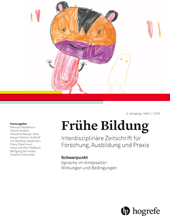Video-Interaktionsbegleitung – eine Methode zur Optimierung der Fachkraft-Kind-Interaktion
Literatur
(2003). Less is more: meta-analyses of sensitivity and attachment interventions in early childhood. Psychological Bulletin , 129 , 195 – 215.
(1990). Video Home Training: Theory Method and Organisation of SPIN. In J. Kool (Ed.), International Seminar for Innovative Institutions (pp. 96 – 112). Ryswijk: Ministry of Welfare, Health and Culture.
(2002). Self-modeling as an effective intervention for students with serious emotional disturbance: Are we modifying children's memories? Psychology in the Schools , 39 , 203 – 207.
(Eds.). (2011). Video Interaction Guidance: A Relationship-Based Intervention to Promote Attunement, Empathy and Wellbeing . London, Philadelphia: Jessica Kingsley Publishers.
(2012). Effects of a video-based interactive advice on the communication behaviour of professionals working with under three years old children . Paper presented at EECERA, Porto, 29.08. – 01.09.2012.
(Hrsg.). (2009). Anwendungsbereiche des Video-Home-Training (VHT). Geglücktes im Blick . Bad Heilbrunn: Klinkhardt.
(2001). Infant intersubjectivity: research, theory, and clinical applications. Journal of Child Psychology and Psychiatry , 42 (1), 3 – 48.



